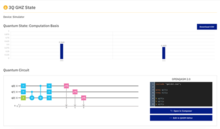The IBM Q Experience is an online platform that gives users in
the general public access to a set of IBM's prototype quantum
processors via the Cloud, an online internet forum
for discussing quantum computing relevant topics, a set of tutorials
on how to program the IBM Q devices, and other educational material
about quantum computing. It is an example of cloud based quantum computing.
As of May 2018, there are three processors on the IBM Q Experience: two
5-qubit processors and a 16-qubit processor. This service can be used
to run algorithms and experiments, and explore tutorials and simulations around what might be possible with quantum computing.
The site also provides an easily discoverable list of research papers
published using the IBM Q Experience as an experimentation platform.
IBM's quantum processors are made up of superconducting transmon qubits, located in a dilution refrigerator at the IBM Research headquarters at the Thomas J. Watson Research Center.
Users interact with a quantum processor through the quantum circuit model of computation, applying quantum gates on the qubits using a GUI called the quantum composer, writing quantum assembly language code or through Qiskit.
IBM's quantum processors are made up of superconducting transmon qubits, located in a dilution refrigerator at the IBM Research headquarters at the Thomas J. Watson Research Center.
Users interact with a quantum processor through the quantum circuit model of computation, applying quantum gates on the qubits using a GUI called the quantum composer, writing quantum assembly language code or through Qiskit.
History
In May 2016, IBM launched the IBM Q Experience,
with a five qubit quantum processor and matching simulator connected in
a star shaped pattern, which users could only interact with through the
quantum composer, with a limited set of two-qubit interactions, and a
user guide that assumed background in linear algebra.
In July 2016, IBM launched the IBM Q Experience community forum.
In January 2017, IBM made a number of additions to the IBM Q Experience,
including increasing the set of two-qubit interactions available on the
five qubit quantum processor, expanding the simulator to custom
topologies up to twenty qubits, and allowing users to interact with the
device and simulator using quantum assembly language code.
In March 2017, IBM released Qiskit
to enable users to more easily write code and run experiments on the
quantum processor and simulator, as well as introduced a user guide for
beginners.
In May 2017, IBM made an additional 16 qubit processor available on the IBM Q Experience.
In January 2018, IBM launched a quantum awards program, which it hosts on the IBM Q Experience.
Quantum Composer
Screen shot showing the result of running a GHZ state experiment using the IBM Quantum Composer
The Quantum Composer is a graphic user interface (GUI) designed by IBM to allow users to construct various quantum algorithms
or run other quantum experiments. Users may see the results of their
quantum algorithms by either running it on a real quantum processor and
using "units" or by using a simulator. Algorithms developed in the
Quantum Composer are referred to as a "quantum score", in reference to
the Quantum Composer resembling a musical sheet.
The IBM Q Experience currently contains a library teaching users
how to use the Quantum Composer. The library consists of two guides:
Beginner's Guide, Full User Guide. There are additional tutorials about
using the IBM Q Experience machines in the github repo for Qiskit
accessed from qiskit.org.
The composer can also be used in scripting mode, where the user can write programs in the QASM-language instead.
Example script
Below
is an example in the QASM-language of a very small program, built for
IBMs 5-qubit computer. The program instructs the computer to generate
the state , a 3-qubit GHZ state, which can be thought of as a variant of the Bell state
but with three qubits instead of just the classical two. It then
measures the state, forcing it to collapse to one of the two possible
outcomes.
include "qelib1.inc"
qreg q[5]; // allocate 5 qubits (set automatically to |00000>)
creg c[5]; // allocate 5 classical bits
h q[0]; // hadamard-transform qubit 0
cx q[0], q[1]; // conditional pauli X-transform (ie. "CNOT") of qubits 0 and 1.
cx q[1], q[2]; // this expands entanglement to the 3rd qubit
measure q[0] -> c[0]; // this measurement collapses the state
measure q[1] -> c[1]; // qubit 1 and 2 read the same value as qubit 0
measure q[2] -> c[2];
Every instruction in the QASM language is the application of a quantum gate, initialization of the chips registers to zero or measurement of these registers.
Beginner's Guide
The
Beginner's Guide introduces users to the terminology and conceptual
knowledge of quantum mechanics needed to compose quantum scores. The
beginners guide introduces readers to the elementary concepts of quantum
computing: behavior of qubits, quantum entanglement, and quantum gates.
Full User Guide
The
full user guide is more in depth and analytical compared to the
beginner's guide, and is recommended for those with experience in linear algebra
or quantum computing. Unlike the beginners guide, the full user guide
contains quantum algorithm examples, with explanations comparing quantum
algorithms to their classical counterparts.
Both of the Beginner and Full User Guides can be updated by anyone via the Qiskit github repository.
Usage
IBM reports that there are over 80,000 users of the IBM Q Experience, who have collectively run over 3 million experiments.
Many of these users are active researchers who have collectively published at least 72 academic papers using the platform.
University professors are also integrating examples and
experiments based on the IBM Q Experience into their educational
curricula.
Dr. Christine Corbett Moran, a postdoctoral fellow at the California Institute of Technology, used the IBM Q Experience while she was doing research in Antarctica.
People have also used the IBM Q Experience for various
non-academic purposes. One user has begun developing games using the IBM
Q Experience, including one titled "quantum battleships".


